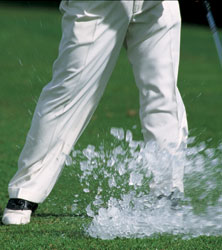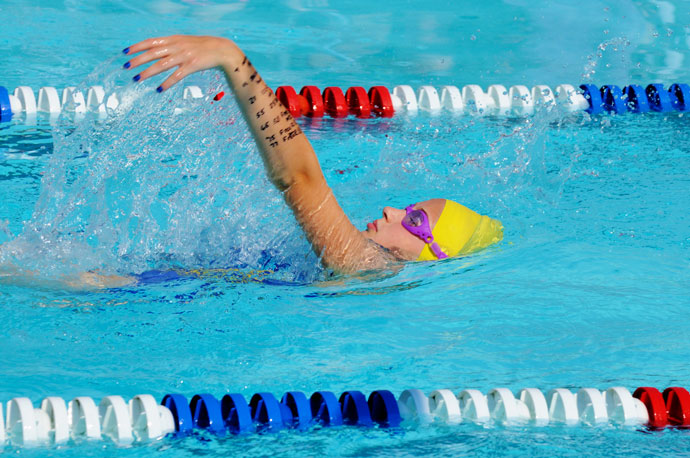catching a thrown ball
Question
I have one 10 year old on my team who, although not klutzy, lacks the ability to catch a thrown ball.
I believe it is a confidence problem. I'm afraid he is going to get himself hurt by someone who throws a ball too fast for him to react to it.
Can you suggest any drills to help him to get his glove in front of a thrown ball?
Answer
Hello Jim,
I understand your compassion for this child and admire coaches who take the time to help weaker children. You'll have to set aside more time for this weaker child in your practices. If you are lucky, have a parent volunteer to help you with the drills. If you have other children who may need some extra help in glove work, it might give the child to know that he is not alone. Also, talk to his parents and see if they can play catch with him at home...consider it homework!!
For a child who needs glove work, a simple game of catch is a good start. Make the distance close enough for success then YOU move back and create more distance between throws. Once he has established confidence with your tosses, slowly increase the velocity.
One of the best drills I can think of is 'rapid fire'. The object is for this child to catch as many balls as possible within a short period of time:
Using tennis balls at first, have the child stand a comfortable distance from you.
Toss the balls rapidly and have the child trap each one correctly in the glove then drop it into a bucket or batting helmet.
You can stop when the helmet is full, within a specified time (1 or 2 minutes) or when all balls have been tossed. Give corrections, adjustments then repeat - 5 times total.
The main idea is to teach him to follow the ball and have his glove up and ready to catch. At first, show him the primary position of his glove based on his position. Work slowly and get him to understand what is expected of him. Increase the velocity as he improves his catching technique. This is also a good practice for the rest of the team, especially the infield! Don't hesitate to use this drill with the other kids. You'd be surprised that not all your players know how to glove a ball correctly.
Assign either an adult volunteer or a teammate to help him. It builds team spirit and character when you tell a better player to help out a weaker one. Make sure the weaker child is always drilled BEFORE every practice. If possible, have him arrive earlier.
When I coached younger kids, I would often create games out of throwing and catching drills. 'Circle toss' is a game requiring two teams. The object is to toss a ball to each player in a circle until it returns to the first player. Once the ball is tossed, the player sits down. The first circle team to be sitting is declared the winner. If a player misses the ball, he or the player immediately behind him has to trap the ball and bring it back into the circle for play. For older kids, I made some changes by making it no longer a game but a drill. You could form one large circle and slowly introduce more than one ball. Do this slowly so that the players acquire the technique with success. Four balls for a 14 player circle is good. IF a player misses a ball or throws badly, he must retrieve the ball THEN run the outside of the circle and return to his circle position.
Another drill I use is 'Follow the ball'. The object is to teach the players to always follow the ball and be quick handed:
Position several players on each base forming a line. The player on 3rd base throws to the player on 1st base AND THEN 'follows the ball' to the rear of the line ON 1st base.
The player on 1st base (who caught the ball) THEN throws the ball to the player on 2nd base AND then 'follows the ball' by running to the end of the line on 2nd base.
The player on 2nd base (who caught the ball) THEN throws the ball to 3rd base AND then 'follows the ball' by running to the end of the line on 3rd base.
Do this until the all players have thrown and caught on every base. HINT: use your best player as the first to throw. When he/she finishes back on 3rd base, stop and review. The first time you use this drill, you may have to slowly walk the kids thru it. Eventually, they will pick up the speed and run thru it very quickly.
It is a great exercise for following the ball, anticipating the throw to base and accuracy.
You can later add penalties for missed balls or bad throws. I have the player run around the outside of the diamond and return to base if they miss a good throw or toss a wild ball.
For your weaker child, it gives him a chance to practice his glovework and throwing accuracy.
You will have to spend some extra time with this player and have him familiar with his glove. Teach him how to 'rest' with his glove; how to 'set up' in anticipation of a tossed ball. Glove up, two hands and a clear view of a tossed ball is basic. THEN instruct the 'crow-hop' technique of catching and returning a ball.
Lastly, make sure everyone knows WHEN to throw a ball to a player. So many times injuries happen because kids don't understand when NOT to throw. A simple nod of the head AND a verbal "OK" is all that it takes. Please instruct them during practice: "If you don't know...Don't throw".
Best of luck,
JohnMc
College Exposure Realities
School News Paper


